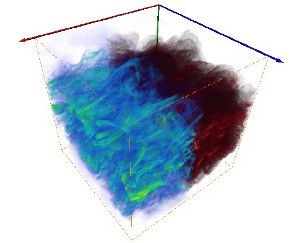|
|  |
According to Einstein's General Theory of Relativity, binary systems
of two neutron stars emit some of their orbital kinetic energy and
angular momentum in the form of gravitational waves. Therefore, the
stars spiral in towards each other until they finally merge. A black
hole forms, swallowing most of the matter immediately. For a short
period of time, however, a small fraction of the gas forms a torus,
which is rotating rapidly about the black hole. In less than a second,
this remnant falls onto the black hole, liberating ultrafast jets of
plasma (akin to a huge and extremely powerful geyser), which are later
an intense source of gamma radiation, a so-called short gamma-ray
burst (GRB).
Most neutron stars possess a magnetic field which can be directly
detected in pulsars. This, in principle, could affect the
merger. Dramatic effects occur only at field strengths largely
exceeding all observed values - even the 100 trillion Gauss observed
for so-called magnetars, the most strongly magnetised neutron
stars. Somewhat weaker effects, however, can occur for smaller field
strengths if the field is amplified during the merger.
As soon as the neutron stars touch each other, a thin layer forms
where the gas is flowing in opposite directions. This contact layer is
unstable against the so-called shear instability (see Fig. 1). After
some time, roughly circular vortices develop. Magnetic field lines
embedded in the gas are stretched by the vortex flow, leading to an
amplification of the field -- similar to the increasing tension of a
rubber band when it is stretched. In previous studies, D. Price and
S. Rosswog estimated that the magnetic field could reach values in
excess of a thousand trillion Gauss by this mechanism; if this holds,
merging neutron stars would be by far the most powerful magnets in the
universe.
For a simulation of the interaction between the gas and the magnetic
field, the model of these fine structures has to be very accurate,
which comes at a high computational cost. On the other hand, to follow
the motion of the two neutron stars one needs to simulate a large
domain that is covering both stars. Even though the extremely high
accuracy is needed only in a small part of this large domain,
simulations of the entire merger that are able to describe in detail
the magnetised turbulence in the contact layer are currently not
feasible.
Large scale models of the merger, which include the final phase of
approach before the neutron stars touch each other, cannot determine
an accurate value of the expected field strength, although they give
an adequate description of the merger process in many other
respects. Scientists at the Max Planck Institute for Astrophysics and
the University of Valencia have therefore performed simulations of
magnetised shear flows resembling those in merging neutron stars. They
considered only regions of a few hundred metres next to the contact
layer, thus simulating only a small part of the entire merger that
encomasses a few tens of kilometres.
The flow is unstable. Initially, the magnetic field grows very rapidly
along with the shear instability. After a short time, however, a
vortex forms and terminates the growth of the shear instability, while
the magnetic field continues to grow as the vortex flow stretches the
field lines (see Fig.2).
The magnetic field affects the gas flow noticeably only if its energy
is comparable to the kinetic energy of the gas. In this case, the
magnetic field is sufficiently strong to resist further stretching and
exerts forces onto the matter. This decelerates the rotation of the
vortex, which means that the field is no longer amplified. In extreme
cases, the vortex can be disrupted completely (see Fig. 3). At this
stage, the magnetic field decreases, partly because its energy is used
to decelerate the flow, partly because of dissipation in secondary
hydro-magnetic instabilities.
The maximum field attainable depends only on the shear flow and not on
the initial field strength. However, the growth of the magnetic field
is not uniform across the whole unstable, turbulent shearing layer. A
huge magnetic field may be built up in only small and localised parts
of the layer, while the rest of the layer retains the initial (weak)
field (see Fig. 4). On average, the mean value of the field is smaller
the weaker the initial field is, and the back-reaction of the field
onto the flow is significantly slower.
In merging neutron stars, these results show that we can indeed expect
extremely strong magnetic fields in the shear flows, even if both
neutron stars are only weakly magnetised. The impact of the field,
however, is limited as only a small fraction of the gas is threaded by
a strong field.
Martin Obergaulinger, Miguel Angel Aloy, Ewald Müller
The computations were performed at the Rechenzentrum Garching (RZG)
and the Barcelona Supercomputing Center - Centro Nacional de
Supercomputación.
Publication
M. Obergaulinger, M.A. Aloy, E. Müller,
"Local simulations of the magnetized Kelvin-Helmholtz instability in neutron-star mergers",
Astronomy & Astrophysics 515 (2010), id.A30
|





